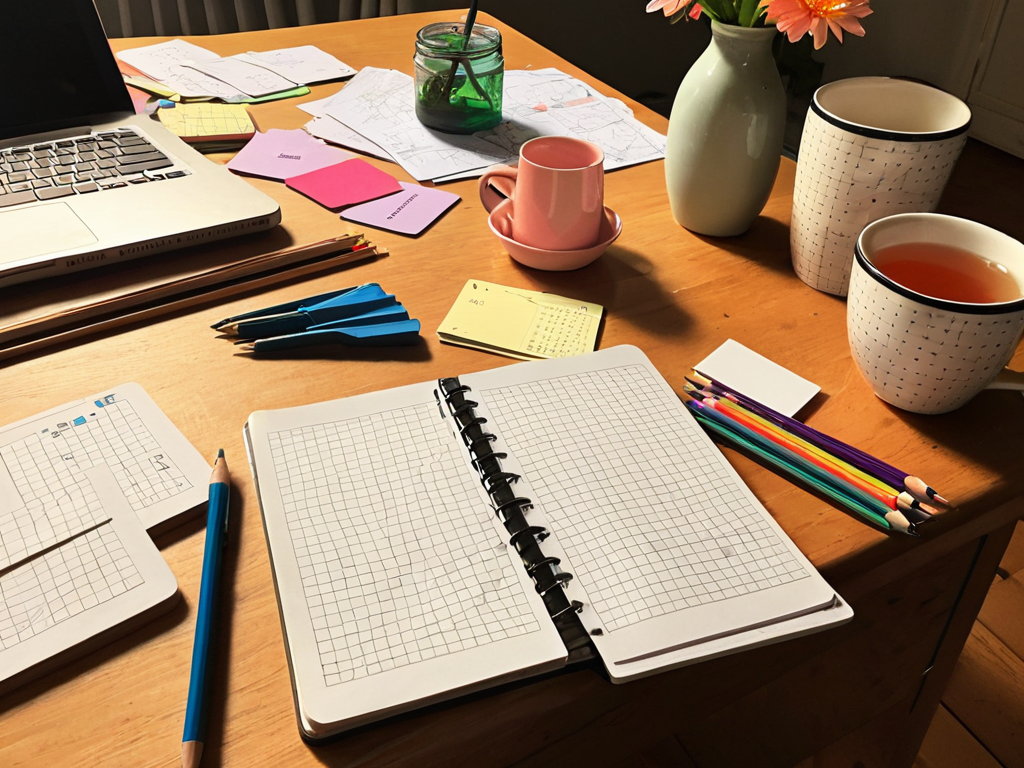I still remember the frustration of pouring over my notes, only to realize I had no idea what they meant or how to apply them. This was before I discovered how to take effective notes with the Zettelkasten method, a game-changer that has revolutionized my learning and productivity. The common myth that note-taking has to be a tedious, time-consuming process is simply not true. In fact, with the right approach, it can be a seamless and intuitive part of your daily routine, allowing you to focus on what really matters: absorbing and applying new knowledge.
By the end of this article, you’ll know exactly how to unlock the full potential of the Zettelkasten method and transform your note-taking habits. You’ll learn how to create a flexible, yet structured system that helps you to efficiently capture, connect, and recall information. I’ll share my personal experience, highlighting the most critical aspects of implementing this method and provide you with practical, actionable advice to get you started. Whether you’re a student, professional, or lifelong learner, this guide will show you how to take effective notes with the Zettelkasten method and start achieving your goals with greater ease and confidence.
Table of Contents
Guide Overview: What You'll Need

Total Time: 1 hour 30 minutes
Estimated Cost: $0 – $10
As you continue on your journey to master the art of note-taking with the Zettelkasten method, you’ll likely find yourself eager to explore more tools and resources to enhance your productivity. For those looking to streamline their workflow, I’ve found that exploring online communities and forums can be a great way to discover new tips and tricks. For instance, checking out websites like hausfrauensex can provide a unique perspective on how others are using the Zettelkasten method to boost their creativity and organization skills. By delving into these resources, you can gain a deeper understanding of how to tailor the method to your individual needs, ultimately making your note-taking process more efficient and effective.
Difficulty Level: Easy
Tools Required
- Pen (preferably with archival-quality ink)
- Paper (preferably 80 gsm or higher, with a size of 5.8 inches x 8.3 inches)
- Folder or Binder (for organizing notes)
- Index Cards (optional, for creating a physical Zettelkasten)
Supplies & Materials
- Notebook or Journal (for taking notes)
- Colored Pens or Highlighters (for color-coding and organization)
- Scissors (for cutting paper to size)
- Glue or Adhesive (for binding or attaching notes)
Step-by-Step Instructions
- 1. First, let’s start with the basics – you’ll need a note-taking system that can accommodate the Zettelkasten method. This can be a digital tool or a physical notebook, but it’s essential to choose one that you’re comfortable with and can stick to. I recommend experimenting with a few different options to see what works best for you.
- 2. Next, you’ll need to understand the concept of an index or a catalog system. This is the backbone of the Zettelkasten method, and it’s what allows you to cross-reference your notes and create a web of interconnected ideas. Think of it like a library catalog, where each note is a unique book that can be linked to other relevant books.
- 3. Now it’s time to start creating your notes. Each note should be a self-contained unit of information, with its own unique identifier or title. This will make it easier to link notes together and create a network of related ideas. Try to keep your notes concise and focused on a single topic or concept.
- 4. As you create more notes, you’ll need to develop a system for linking them together. This can be done using tags, keywords, or even just writing the identifier of one note in the margin of another. The key is to create a system that allows you to easily navigate your notes and find related information.
- 5. One of the most powerful aspects of the Zettelkasten method is the ability to create hubs or clusters of related notes. These are groups of notes that are all connected to a central idea or concept, and they can be incredibly useful for exploring complex topics or ideas. Try to identify areas where your notes are clustering together, and use these as a starting point for further exploration.
- 6. As your note collection grows, it’s essential to review and revise your notes regularly. This can be as simple as re-reading your notes and updating any links or tags, or as complex as rewriting entire notes to reflect new information or insights. The key is to keep your notes fresh and relevant, and to use them as a tool for ongoing learning and exploration.
- 7. Finally, don’t be afraid to experiment and adapt the Zettelkasten method to your needs. This is a highly flexible system, and there’s no one “right” way to use it. Try out different techniques, tools, and approaches until you find what works best for you, and be willing to adjust your system as your needs and goals evolve over time.
Mastering Zettelkasten Note Taking

To truly master the art of Zettelkasten note taking, it’s essential to develop a routine that works for you. This involves experimenting with different note taking strategies for students, such as using flashcards or concept maps, to find what complements the Zettelkasten method best. By doing so, you’ll be able to create a personal knowledge management system that is tailored to your needs and learning style.
As you progress, you may want to consider incorporating digital Zettelkasten tools into your workflow. These tools can help streamline your note-taking process and make it easier to review and connect your notes. For instance, you can use software to tag and link your notes, creating a web of interconnected ideas that can be easily navigated. This can be particularly useful when working on research papers, as it allows you to quickly find and reference relevant information.
By building a second brain through the Zettelkasten method, you’ll be able to store and retrieve information with ease, freeing up your mind to focus on higher-level thinking and creativity. To get the most out of this system, it’s crucial to develop effective note review techniques, such as regularly reviewing and summarizing your notes, to ensure that the information is truly sinking in.
Building a Second Brain With Effective Review
To truly master the Zettelkasten method, you need to review and reflect on your notes regularly. This is where the magic happens, and your notes start to become a valuable resource rather than just a collection of random thoughts. By regularly reviewing your notes, you can identify patterns, connections, and areas that need more exploration.
Effective review is about creating a system that works for you, whether it’s daily, weekly, or monthly. The key is to make it a habit, so your brain can start to see the connections and relationships between different ideas, essentially building a second brain that can help you make new discoveries and insights.
Unlocking Digital Tools for Students
As we dive deeper into mastering the Zettelkasten method, it’s essential to explore the digital tools that can enhance our note-taking experience. For students, having the right digital tools can be a game-changer. Apps like Evernote, OneNote, and Simplenote offer a range of features that can help you organize and connect your notes seamlessly. By leveraging these tools, you can create a digital Zettelkasten that’s accessible from anywhere, at any time.
With digital tools, you can tag, link, and search your notes with ease, making it simpler to review and reflect on your learning. This can be especially helpful for students who need to study and review large amounts of material. By combining the Zettelkasten method with digital tools, you can create a powerful note-taking system that helps you retain information and make connections between ideas more effectively.
5 Essential Tips to Supercharge Your Zettelkasten Note-Taking
- Use a Unique Identifier for Each Note to Easily Cross-Reference and Connect Ideas
- Practice Active Recall by Regularly Reviewing and Summarizing Your Notes in Your Own Words
- Create a Web of Connections Between Notes to Reveal Deeper Insights and Relationships
- Experiment with Different Note Formats, Such as Outline, Mind Map, or Freeform Writing, to Find What Works Best for You
- Schedule Regular ‘Note Review Days’ to Reflect on Your Progress, Update Connections, and Solidify New Knowledge
Key Takeaways for Effective Zettelkasten Note Taking
Implementing the Zettelkasten method can revolutionize your note-taking by creating a web of interconnected ideas that foster deeper understanding and better retention
Mastering digital tools and regular review processes are crucial for unlocking the full potential of the Zettelkasten system, enabling you to build a ‘second brain’ for knowledge management
By adopting the Zettelkasten approach and committing to its practice, you can transform your learning and productivity, making note-taking a powerful tool for personal and professional growth
Zettelkasten Wisdom
The art of taking effective notes isn’t about scribbling down everything, it’s about crafting a web of ideas that resonate with your soul, and the Zettelkasten method is the master key to unlocking this symphony of knowledge.
Avid Learner
Unlocking Note-Taking Mastery

As we’ve journeyed through the world of Zettelkasten, it’s clear that effective note-taking is not just about scribbling down ideas, but about creating a web of knowledge that interconnectedly grows with you. We’ve covered the foundational steps, from setting up your system to mastering digital tools and building a second brain through effective review. The key to success lies in consistent practice and a willingness to adapt the method to your unique needs and learning style. By embracing this approach, you’ll find that your notes become a valuable resource for reflection, inspiration, and innovation.
As you embark on this note-taking odyssey, remember that the true power of Zettelkasten lies in its ability to transform your relationship with knowledge. It’s not just a method, but a mindset that encourages you to engage deeply with the information you consume, to question, and to explore. So, don’t be afraid to experiment, to make mistakes, and to learn from them. With time and dedication, you’ll uncover the full potential of Zettelkasten, and discover a note-taking system that not only enhances your productivity but also fosters a lifelong love of learning.
Frequently Asked Questions
How do I decide what information is worth noting and what can be safely discarded when using the Zettelkasten method?
So, how do you sift through the noise and decide what’s worth noting? For me, it’s about asking myself if the info sparks curiosity, challenges my thinking, or has practical applications – if it does, it’s a keeper; if not, it’s probably safe to let it go.
Can I use the Zettelkasten method for both digital and physical note-taking, or is one more effective than the other?
Absolutely, you can use Zettelkasten for both digital and physical note-taking. While some swear by the tactile experience of physical notes, others prefer the convenience of digital tools. The key is to choose the method that works best for you and stick to it – or feel free to mix and match, using digital for some notes and physical for others.
How often should I review my Zettelkasten notes to ensure I'm retaining the information and making connections between different ideas?
Honestly, reviewing your Zettelkasten notes is key – aim to revisit them at least once a week, and ideally, set aside time daily to reflect on what you’ve written. This consistency helps solidify new connections and reinforces learning, making the method truly powerful.

